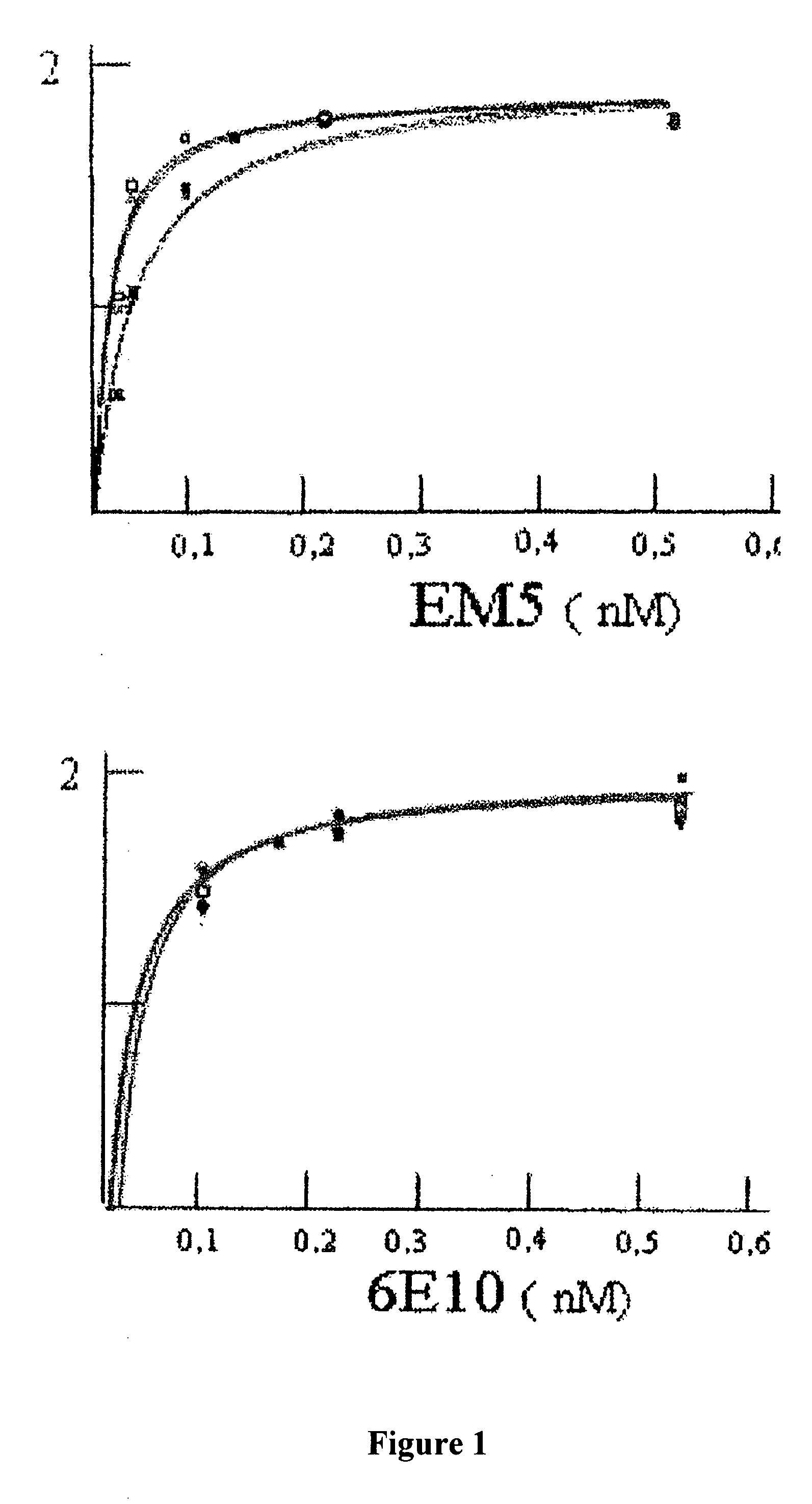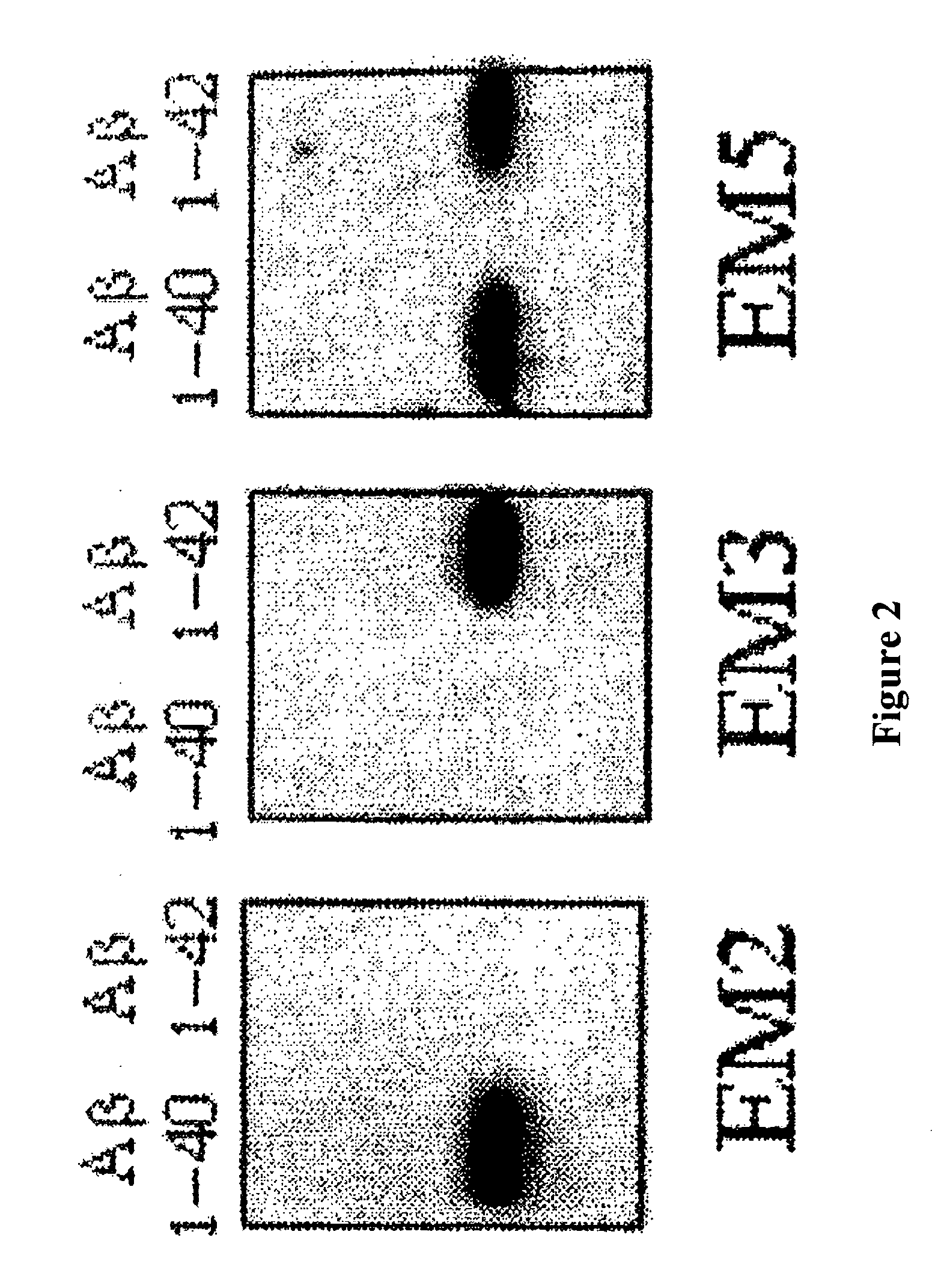Method for the in vitro diagnosis of alzheimer's disease using a monoclonal antibody
a monoclonal antibody and alzheimer's disease technology, applied in the field of neurological disorders, can solve the problems of gradual deterioration of cognitive abilities, changes in personality, behavioral problems, and eventually death, and achieve the effect of facilitating extraction of isoforms and facilitating their subsequent detection, identification and/or quantification
- Summary
- Abstract
- Description
- Claims
- Application Information
AI Technical Summary
Benefits of technology
Problems solved by technology
Method used
Image
Examples
example 1
Production of Antibodies
[0057]The polyclonal antibodies EM2 and EM5 used in this study were produced in the manner reported previously [24].
[0058]The following steps were carried out for production of the EM5 monoclonal antibody:
[0059]Production of Hybridomas
[0060]BALB / c mice were injected subcutaneously with 40 μg of peptide API-4 coupled to KLH (keyhole limpet heamocyanin) and dissolved in phosphate-buffered saline (PBS) and emulsified with an equal volume of Freund complete adjuvant. The mice received three injections repeated every other week, in Freund incomplete adjuvant. Three days before fusion, the mice received an intraperitoneal injection of 25 μg of Aβ1-40-KLH in PBS. On the day of fusion, spleen cells from animals immunized with the mouse myeloma line P3 / X63-Ag.653 were fused using polyethylene glycol 1400 (Sigma), following established procedures [25]. The fused cells were distributed in sterile 96-well plates at a density of 105 cells per well and were selected in med...
example 2
Calculation of the Apparent Dissociation Constant
Affinity for Peptides Aβ1-40 and Aβ1-42
[0065]ELISA was used for investigating the affinity of EM5 and 6E10 monoclonal antibodies using recently dissolved, immobilized peptides Aβ1-40 and Aβ1-42, which had been synthesized in the WM Keck plant of Yale University using the N-t-butyloxycarbonyl methodology.
[0066]Polystyrene microtitre plates (Immulon 2, Dynex Technology Inc., Chantilly, Va.) were covered for 16 hours at 4° C. with 0.5 μg of peptide Aβ1-40 or Aβ1-42 recently dissolved or aggregated in carbonate / bicarbonate buffer pH 9.6. After blocking with Superblock (Pierce Chemical Co.), increasing concentrations of purified EM5 (0-0.5 nM in TBS-T, 100 microliters per well) were added to the wells covered with Aβ, incubating for 3 hours at 37° C. The bound EM5 was detected with the F(ab′)2 fragment of goat anti-mouse IgG conjugated with horseradish peroxidase (1:3000, Amersham). The reaction was developed for 15 minutes with 3,3′,5,5′...
example 3
Immunotransfer Analysis
[0068]The specific recognition of Aβ1-40 and Aβ1-42 by EM5 was investigated and compared with EM2 and EM3 polygonal antibodies by means of immunotransfer analysis. For this, Aβ peptides (0.5 μg / lane) were submitted to PAGE electrophoresis in 16% acrylamide, tris-tricine-SDS. The peptides were transferred electrophoretically for 1 hour at 400 mA and 4° C. to poly(vinylidene fluoride) membranes (Immobilon-P, Millipore) using 3-cyclohexylamino-1-propanesulfonic acid, pH 11, containing 10% methanol. The membranes were blocked for 16 h at 4° C. with TBS-T containing 5% powdered skimmed milk and were then incubated for 1 hour at room temperature with 2 μg / ml of IgGs EM2, EM3 or EM5. A goat anti-rabbit IgG (EM2 and EM3) or goat anti-mouse IgG (EM5) coupled to horseradish peroxidase (Amersham) and diluted 1:2000 was used as the second antibody. Immunotransfer was visualized by means of chemoluminescence (Amersham) following the manufacturer's specifications.
[0069]The ...
PUM
| Property | Measurement | Unit |
|---|---|---|
| Concentration | aaaaa | aaaaa |
| Magnetic field | aaaaa | aaaaa |
| Solubility (mass) | aaaaa | aaaaa |
Abstract
Description
Claims
Application Information
 Login to View More
Login to View More - R&D
- Intellectual Property
- Life Sciences
- Materials
- Tech Scout
- Unparalleled Data Quality
- Higher Quality Content
- 60% Fewer Hallucinations
Browse by: Latest US Patents, China's latest patents, Technical Efficacy Thesaurus, Application Domain, Technology Topic, Popular Technical Reports.
© 2025 PatSnap. All rights reserved.Legal|Privacy policy|Modern Slavery Act Transparency Statement|Sitemap|About US| Contact US: help@patsnap.com



